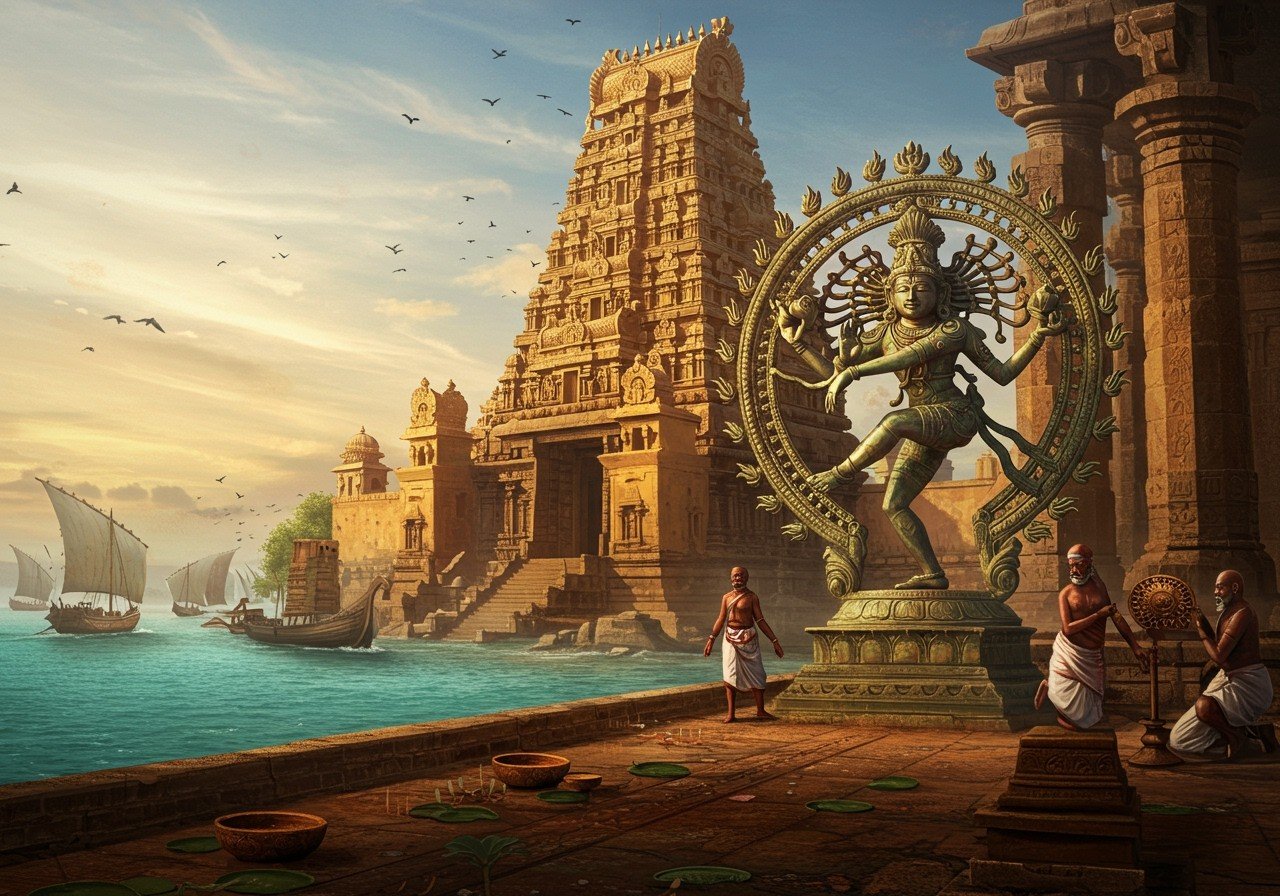
The Chola Dynasty, a prominent empire in South Indian history, reigned for centuries, leaving an indelible mark on the region’s culture, politics, and architecture. For those preparing for the UPSC exam, understanding this dynasty is crucial, as it forms a significant part of the Ancient History syllabus. This guide delves into the history, administration, economy, culture, and key contributions of the Cholas, providing a holistic view essential for UPSC preparation.
Historical Background: From Inception to Apex
The Chola Dynasty’s origins trace back to ancient texts, gradually emerging as a dominant force in Southern India. Karikala Chola, renowned for military prowess and architectural initiatives, expanded the kingdom significantly. Vijayalaya Chola, another key figure, marked the transition to the Imperial Chola era by strategically capturing Thanjavur in 850 CE. The dynasty’s influence peaked during the reign of Raja Raja Chola I and his son Rajendra Chola I, who extended the empire’s reach across the Indian Ocean.
This era, known as the Imperial Chola period (850-1070 CE), witnessed remarkable territorial expansion and consolidation of power. However, the dynasty eventually declined due to internal conflicts and the rise of rival kingdoms like the Pandyas in the early 13th century.
Administration and Governance: A Well-Oiled Machine
The Chola administration was remarkably sophisticated for its time. The king, at the helm, was aided by a council of ministers and provincial governors. A unique feature was the presence of village assemblies called “sabha,” demonstrating a degree of local self-governance. These assemblies managed local affairs, reflecting a decentralized approach to administration. The judicial system, with established legal procedures, ensured law and order, while a robust revenue system, including land surveys and efficient tax collection, supported the empire’s economic stability. The Cholas also maintained a formidable military, including a powerful navy that projected their power across maritime routes.
Economic Prosperity: Agriculture, Trade, and Maritime Dominance
The Chola economy flourished due to a combination of agricultural advancements and vibrant trade networks. The construction of the Grand Anicut, a marvel of irrigation engineering, significantly enhanced agricultural productivity. Temples served not only as religious centers but also as economic hubs, facilitating trade and commerce. Extensive maritime trade routes connected the Cholas with Southeast Asia, China, and the Arabian Peninsula, fostering economic exchange and cultural interaction. This maritime dominance contributed significantly to the empire’s wealth and influence.
Cultural Contributions: A Legacy of Art, Architecture, and Literature
The Cholas left behind a rich cultural legacy, particularly in art, architecture, and literature. The magnificent Brihadeshwara Temple in Thanjavur, built by Raja Raja Chola I, stands as a testament to their architectural prowess and a prime example of Dravidian architecture. Tamil literature flourished under Chola patronage, with renowned poets and scholars contributing to its rich tapestry. Shaivism and Vaishnavism were prominent religious sects, with temples playing a central role in religious and social life. The Cholas’ cultural influence extended to Southeast Asia, impacting art, architecture, and language in the region.
Key Takeaways for UPSC Aspirants
For UPSC aspirants, a deep understanding of the Chola Dynasty is essential. Focus on the following key aspects:
- Important Rulers and their Contributions: Karikala Chola, Vijayalaya Chola, Raja Raja Chola I, and Rajendra Chola I are crucial figures to study. Understand their achievements and impact on the dynasty’s trajectory.
- Administrative Structure: The Chola administrative system, including the role of village assemblies (“sabha”), the judicial system, and revenue administration, is important. Analyze their decentralized approach to governance and its effectiveness.
- Economic Policies: Understand the factors contributing to Chola economic prosperity, such as the Grand Anicut’s impact on agriculture and their extensive maritime trade networks.
- Cultural Achievements: Pay attention to the architectural marvels like the Brihadeshwara Temple, the flourishing of Tamil literature, and the prominence of Shaivism and Vaishnavism during the Chola period. Recognize the influence of Chola culture on Southeast Asia.
- Timeline and Key Events: Be familiar with the different periods of Chola rule (Sangam Chola, Imperial Chola, Later Chola) and the major events associated with each.
For a deeper understanding of the religious practices of the Chola Dynasty, consider exploring the authentic ritual items and educational resources available at poojn.in. You can find a variety of products related to temple worship and deity veneration, including brass lamps, copper vessels, and puja items specific to deities like Lord Shiva, Kartikeya, Ganesha, and Vishnu.
You can also delve deeper into the architectural wonders of the Sas Bahu Temples with our detailed guide available at https://www.poojn.in/post/17740/sas-bahu-temples-a-guide-to-their-architectural-wonders. It offers valuable insights into the architectural marvels of that era. For a comprehensive exploration of India’s Sas Bahu Temples, including their locations, history, and significance, visit https://www.poojn.in/post/17743/indias-sas-bahu-temples-a-complete-guide-to-locations-history-and-significance.
Additionally, explore the rich history and significance of Kandariya Mahadeva Temple at https://www.poojn.in/post/17731/kandariya-mahadeva-temple-religious-importance-and-history and embark on a cultural heritage journey through Khajuraho and Kandariya Mahadeva at https://www.poojn.in/post/17734/khajuraho-and-kandariya-mahadeva-a-cultural-heritage-journey.
By thoroughly studying these aspects, you’ll be well-prepared for any questions related to the Chola Dynasty in the UPSC exam. This knowledge will not only enhance your understanding of Indian history but also provide valuable insights into the rich cultural tapestry of South India.


